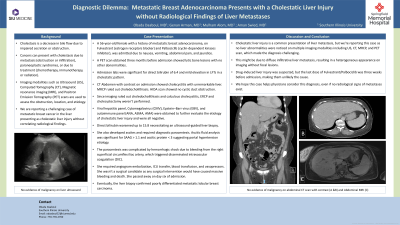Monday Poster Session
Category: Liver
P3151 - Diagnostic Dilemma: Metastatic Breast Adenocarcinoma Presents with a Cholestatic Liver Injury without Radiological Findings of Liver Metastases
Monday, October 28, 2024
10:30 AM - 4:00 PM ET
Location: Exhibit Hall E

Has Audio

Obada Daaboul, MD
Southern Illinois University
Springfield, IL
Presenting Author(s)
Obada Daaboul, MD, Genan Arman, MD, Mulham Alom, MD, Aman Swied, MD
Southern Illinois University, Springfield, IL
Introduction: Cholestasis is a decrease in bile flow due to impaired secretion or obstruction. Cancers can present with cholestasis due to metastasis (obstruction or infiltration), paraneoplastic syndromes, or due to treatment (chemotherapy, immunotherapy, or radiation). Imaging modalities such as US, CT, MRI, and PET are used to assess the obstruction, location, and etiology. We’re reporting a challenging case of metastatic breast cancer in the liver presenting as cholestatic liver injury without correlating radiological findings.
Case Description/Methods: A 56-year-old female with metastatic breast adenocarcinoma, on Fluvestrant and Palbociclib, admitted due to nausea, vomiting, abdominal pain, and jaundice. A recent PET scan showed lytic bone lesions with no other abnormalities. CT Abdomen with contrast showed cholecystitis with unremarkable liver. Labs were significant for direct bilirubin of 6.4 and mild elevation in LFTs in a cholestatic pattern. MRCP ruled out choledocholithiasis. HIDA scan showed no cystic duct obstruction. Since imaging ruled out choledocholithiasis and calculous cholecystitis, ERCP and cholecystectomy weren’t performed. Viral hepatitis panel, CMV, EBV, and autoimmune panel (ANA, ASMA, AMA) were negative. Direct bilirubin worsened to 15.8 necessitating US guided liver biopsy. She also developed ascites and required diagnostic paracentesis which showed no specific findings. Paracentesis was complicated by hemorrhagic shock due to bleeding from the right superficial circumflex iliac artery, which triggered DIC. She required angiogram embolization, ICU transfer, blood transfusion, and vasopressors. She wasn’t a surgical candidate as any surgical intervention would cause massive bleeding and death. Her family elected for comfort care and she passed away on day 7 of admission. Eventually, the liver biopsy confirmed poorly differentiated metastatic lobular breast carcinoma.
Discussion: Cholestatic liver injury is a common presentation of liver metastasis, but we’re reporting this case as no liver abnormalities were noticed on multiple imaging modalities including US, CT, MRCP, and PET, which made the diagnosis challenging. This might be due to diffuse liver metastasis, resulting in a heterogeneous appearance without focal lesions. Drug-induced liver injury was suspected, but the last dose of Fulvestrant/Palbociclib was three weeks before admission, making them unlikely the cause. We hope this case helps physicians consider this diagnosis, even if no radiological signs of metastases exist.
Disclosures:
Obada Daaboul, MD, Genan Arman, MD, Mulham Alom, MD, Aman Swied, MD. P3151 - Diagnostic Dilemma: Metastatic Breast Adenocarcinoma Presents with a Cholestatic Liver Injury without Radiological Findings of Liver Metastases, ACG 2024 Annual Scientific Meeting Abstracts. Philadelphia, PA: American College of Gastroenterology.
Southern Illinois University, Springfield, IL
Introduction: Cholestasis is a decrease in bile flow due to impaired secretion or obstruction. Cancers can present with cholestasis due to metastasis (obstruction or infiltration), paraneoplastic syndromes, or due to treatment (chemotherapy, immunotherapy, or radiation). Imaging modalities such as US, CT, MRI, and PET are used to assess the obstruction, location, and etiology. We’re reporting a challenging case of metastatic breast cancer in the liver presenting as cholestatic liver injury without correlating radiological findings.
Case Description/Methods: A 56-year-old female with metastatic breast adenocarcinoma, on Fluvestrant and Palbociclib, admitted due to nausea, vomiting, abdominal pain, and jaundice. A recent PET scan showed lytic bone lesions with no other abnormalities. CT Abdomen with contrast showed cholecystitis with unremarkable liver. Labs were significant for direct bilirubin of 6.4 and mild elevation in LFTs in a cholestatic pattern. MRCP ruled out choledocholithiasis. HIDA scan showed no cystic duct obstruction. Since imaging ruled out choledocholithiasis and calculous cholecystitis, ERCP and cholecystectomy weren’t performed. Viral hepatitis panel, CMV, EBV, and autoimmune panel (ANA, ASMA, AMA) were negative. Direct bilirubin worsened to 15.8 necessitating US guided liver biopsy. She also developed ascites and required diagnostic paracentesis which showed no specific findings. Paracentesis was complicated by hemorrhagic shock due to bleeding from the right superficial circumflex iliac artery, which triggered DIC. She required angiogram embolization, ICU transfer, blood transfusion, and vasopressors. She wasn’t a surgical candidate as any surgical intervention would cause massive bleeding and death. Her family elected for comfort care and she passed away on day 7 of admission. Eventually, the liver biopsy confirmed poorly differentiated metastatic lobular breast carcinoma.
Discussion: Cholestatic liver injury is a common presentation of liver metastasis, but we’re reporting this case as no liver abnormalities were noticed on multiple imaging modalities including US, CT, MRCP, and PET, which made the diagnosis challenging. This might be due to diffuse liver metastasis, resulting in a heterogeneous appearance without focal lesions. Drug-induced liver injury was suspected, but the last dose of Fulvestrant/Palbociclib was three weeks before admission, making them unlikely the cause. We hope this case helps physicians consider this diagnosis, even if no radiological signs of metastases exist.
Disclosures:
Obada Daaboul indicated no relevant financial relationships.
Genan Arman indicated no relevant financial relationships.
Mulham Alom indicated no relevant financial relationships.
Aman Swied indicated no relevant financial relationships.
Obada Daaboul, MD, Genan Arman, MD, Mulham Alom, MD, Aman Swied, MD. P3151 - Diagnostic Dilemma: Metastatic Breast Adenocarcinoma Presents with a Cholestatic Liver Injury without Radiological Findings of Liver Metastases, ACG 2024 Annual Scientific Meeting Abstracts. Philadelphia, PA: American College of Gastroenterology.
